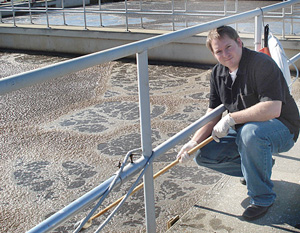Norman says antibiotic resistant bacteria could emerge as serious problem for coastal residents
March 19, 2009
In one of those strange turns of life, USC researcher Dr. Sean Norman is busy these days studying a variety of pathogenic bacteria that sickened and nearly killed him as a healthy teenager.
“I was healthy and physically fit. Played football. But my fever was so high the doctors wondered if I’d make it,” said Norman, an assistant professor at the Arnold School’s Department of Environmental Health Sciences.
This story is testimony that Norman survived but he had a close call because the origin of his illness was a strain of antibiotic resistant bacteria. The consequence of the widespread overuse of medicines to kill bacteria, these bacterial mutations have emerged as a formidable public health concern, killing more than 100,000 U.S. residents annually and hospitalizing even more.

Norman samples activated sludge at a coastal
wastewater treatment plant.
Some bacteria – so-called “superbugs” -- that once were easily controlled are now resistant to even the strongest antibiotics. The economic costs of the problem, while difficult to calculate, have been projected into the billions of dollars annually.
Against this backdrop Norman has embarked on a study that he hopes will help minimize the spread of antibiotic resistant bacteria in the fast-growing coastal regions of the U.S. and elsewhere.
Norman, an environmental microbiologist by profession, has been studying bacterial genes he has discovered lurking in treated wastewater (sewage) effluent. Some of those genes, he found, can confer bacterial resistance to at least five antibiotics.
Norman says an analysis of one of the genes suggests that it likely entered the treatment plant inside a human pathogen that was subsequently killed by the treatment process.
Freed from the human pathogen, the gene was transferred to an environmental pathogen that can survive treatment and can ultimately be discharged.
“Finding these genes in any marine environments – particularly in oysters and other shellfish, that people consume -- would show the potential for the harmful gene to come full cycle.” he said. At present it is unknown if this is a possible route, but as a precaution, Dr. Norman is studying the possibility further to better understand how antibiotic resistance genes move among bacteria found in natural systems.
Bacterial resistance is not isolated to coastal environments, but considering that one-half of the world’s population resides within 120 miles of a coastline, his coastal studies have widespread implications to public health and the health of our oceans.



_01.jpg)
_02.jpg)